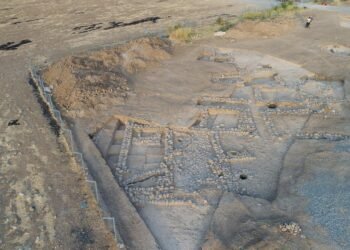Archaeologists from the Nicolaus Copernicus University in Toruń, Poland, have recently unveiled a reconstructed image of a woman interred in a 17th-century “vampire” grave near the village of Pień, Dąbrowa Chełmińska municipality. Discovered in 2022 by a research team led by Prof. Dariusz Poliński, the grave contained human remains buried with a sickle placed over the neck and a padlock fastened to the big toe of the left foot—objects believed to have been placed to prevent the deceased from returning as a revenant or vampire.

Dubbed “the Vampire of Pień” in popular science circles, the burial reflects a period in European folklore when superstition surrounding vampires and the supernatural was rampant. Archaeological evidence and historical context suggest that during the late 17th and 18th centuries, fear of vampires permeated various European cultures, where individuals believed that the dead could rise and harm the living. This particular grave, likely influenced by such beliefs, hints at how communities may have dealt with perceived threats of the supernatural.
Related: Remains of a “female vampire” have been unearthed in Poland
The interdisciplinary team responsible for the reconstruction was part of the Pień Project and included anthropologists, medical experts, and forensic specialists. A 3D model of the woman’s skull served as the foundation for recreating her probable appearance. Dr. Alicja Drozd-Lipińska from the Museum in Włocławek conducted anthropological studies on the skeleton, while Dr. Łukasz Czyżewski from the Institute of Archaeology at Nicolaus Copernicus University prepared materials for the 3D printing of the skull. According to the Toruń Educational Association “Evolution,” which has been sharing updates on the project, DNA analyses, and isotopic research suggest that the woman might have had Scandinavian ancestry.
Medical investigations also revealed that the woman suffered from a hemangioma—a tumor located in the sternum. This condition, which could have been painful and might have caused visible chest deformities, was confirmed through tomographic examinations. Hematologist Maria Czyżewska coordinated consultations with experts in radiology, hematology, orthopedics, and pathology. Forensic anthropologist Dr. Heather Edgar from the University of New Mexico reviewed the findings and supported the link between the tumor and symptoms like pain and possible fainting spells, which could have contributed to the woman’s perceived otherness in a superstitious society.
The research team’s meticulous work included DNA testing performed by Dr. Magnus Lundgren from SciLifeLab’s Ancient DNA program at Uppsala University, Sweden, and isotopic analyses by Ph.D. candidate Paige Lynch from the University of New Mexico. The results helped shape the reconstructed image of the “Vampire of Pień,” providing a detailed look at what the woman may have looked like in life.
Ongoing investigations at the Pień cemetery also aim to uncover further historical insights. Fieldwork in 2024 included UV lamp testing to identify bone surfaces, a technique pioneered by researcher Karol Woliński. Geophysical studies conducted by Wiesław Małkowski’s team from the University of Warsaw have detected anomalies that could indicate additional burials, with further field research planned for 2025.






















